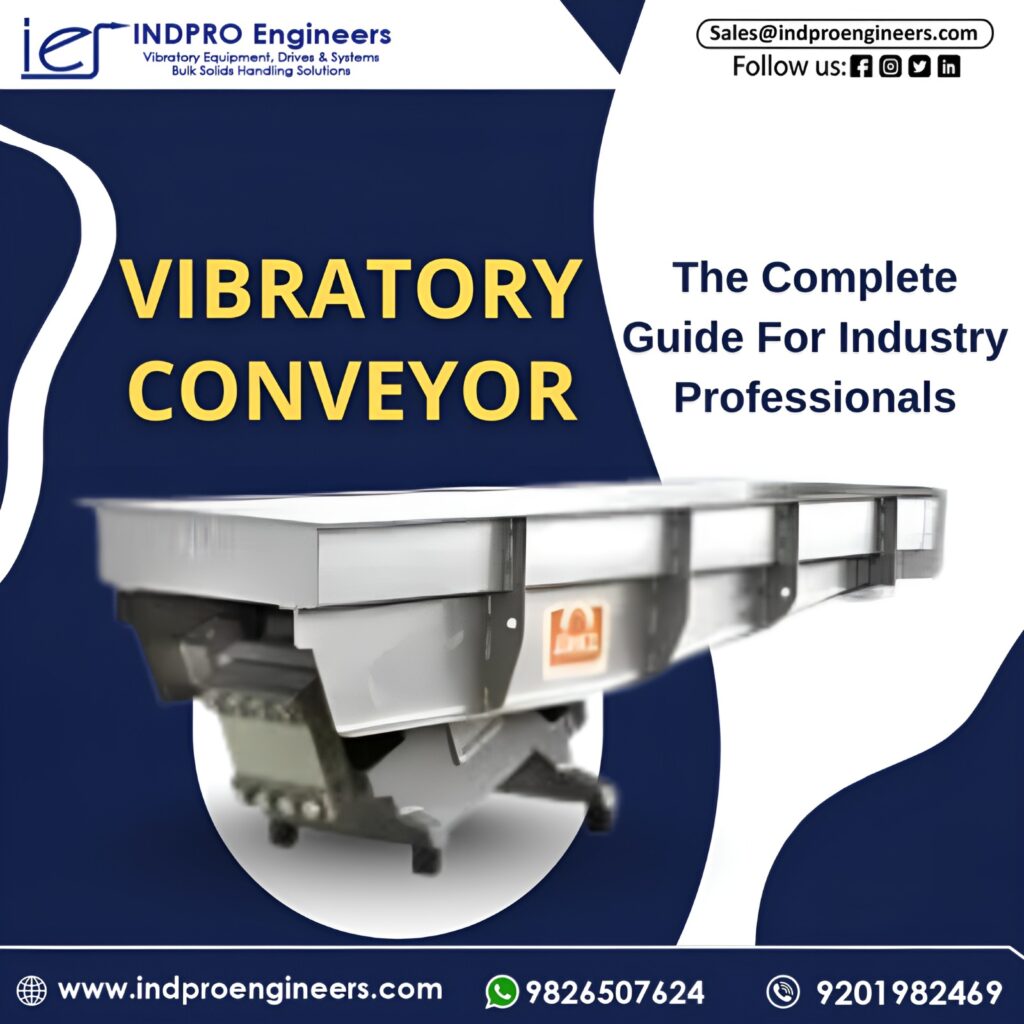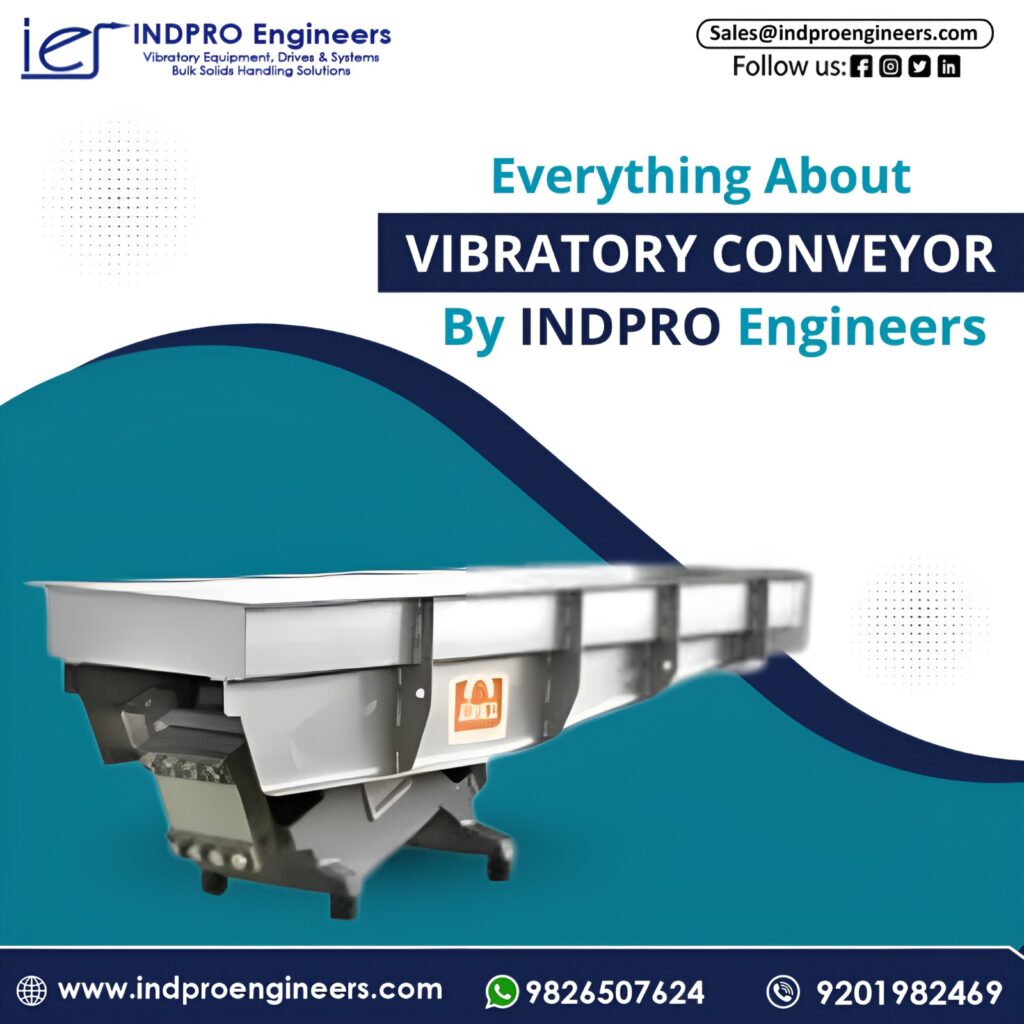
Vibratory Conveyor: The Complete Guide for Industry Professionals
- posted by: Indpro Engineers
- No Comments
- vibratory conveyor
Just imagine the following situation: you are managing the operations in a food processing plant. Your manufacturing process is smooth, but every so often, there is a block. The bins become clogged with powders. The flow of materials is uneven. It requires manual involvement. It take everything slowly.
And that was the issue being experienced by a food manufacturer in Madhya Pradesh. Poor flow by hoppers and silos kept on stalling their operations several times a day. The solution? The combination of the Vibratory Conveyor system with bin fluidizers, bin vibrators, and the change was impressive.
So, let us go into detail about what a vibratory conveyor is and what actual industrial issue it can resolve.
What is a Vibratory Conveyor?
A vibratory conveyor is a mechanical conveyor system that transports bulk material by means of vibration as opposed to the use of belts, chains, or rollers. These conveyors are best suited for the transfer of fine powders, granules, pellets, and even delicate goods such as food products.
Vibratory conveyors, when compared with traditional systems, provide a vibration that moves materials induced by gentle and precise vibration along the surface of a tray, tube, or trough. These systems especially apply in the industrial settings such as
- Sustenance and drink
- Pharmaceuticals
- Chemicals
- Mining
- Fertilizers
The materials discharge equipment is usually found in combination with vibratory systems such as the use of bin fluidizers, bin vibrators, and vibratory feeders to make the flow of material smooth.
Vibratory Conveyor: How Does It Operate?
- The working principle is easy yet effective.
- Vibrations are produced by an electric motor or an electromagnetic drive.
- The conveyor tray or tube receives these vibrations.
- The content on the tray flips or slides forward in precise movement.
Several systems have a vibratory feeder at the head to keep material pouring into the conveyor and a bin fluidizer or bin vibrator under storage bins to prevent material in the bins from bridging and starving the system at the head end. These elements facilitate the freeing of clumps of material and also avoid bridging, promoting a regular material feeding.
For delicate materials or dusty environments, a vibratory tube feeder can be used. It’s an enclosed version of the standard tray conveyor that prevents contamination and material loss.
Types of Vibratory Conveyors
There are various types of vibratory conveyors designed to suit different applications. Here are the most common:
- Natural Frequency Vibratory Conveyor
- Forced Frequency Conveyor
- Vibratory Tube Feeder
- Inclined vibratory conveyor
- Vibratory Feeder
- Bin Vibrator
- Bin Fluidizer
Together, these components create a complete flow solution from storage to processing.
Cost of Vibratory Conveyors
The price of a vibratory conveyor depends upon:
- Size and capacity
- Type of material (e.g., stainless steel and mild steel)
- Drive relay (electromagnetic; mechanical)
Other parts, such as vibratory feeders, bin fluidizers, and bin vibrators,
Price Range:
- Small Units: ₹50,000 – ₹1.5 Lakhs
- Medium Industrial Systems: ₹1.5 Lakhs – ₹5 Lakhs
- Custom Solutions (including vibratory tube feeder or vibratory screener): ₹5 lakhs and above
The initial investment may be large; nevertheless, the ROI is favorable. The system can be paid off in months with reduced downtimes, easy flow, and increased production.
The buying guide to vibratory conveyors.
A checklist to consider to buy the correct vibratory conveyor will be as follows:
- Know Your Stuff
Is your matter free-flowing or sticky? Fine or grain? The answer will decide whether you would require special devices like a bin fluidizer or vibratory feeder.
- Throughput Requirements
How much material do you require to be moved per hour? Select a system sufficient to at least this figure.
- Space Constraints
Does your plant have restricted space? In this case, opt for compact designs such as vibratory tube feeders.
- Automation degree
Labor is easily halved by using automated systems, where the sensors and vibratory screeners make the whole process a lot more accurate.
- Maintenance and Support
Ask a vendor which provides a good after-sales service, particularly on important components such as bin vibrators and drive units.
Indian best manufacturing company.
There are some of the main manufacturers and producers of vibratory solutions in India. It is one of the finest in the industry.
Indpro Engineers Technologies
The reason why Indpro engineers are special:
- Design and engineering service
- Complete spectrum: vibratory conveying, vibratory feeders, bin fluidizing, vibratory tube feeding, and vibratory screeners
- Global standards made in India
- Speedy delivery and good service
Before finalizing a supplier, always check for:
- Industry experience
- Customization capability
- Quality certifications
- Customer testimonials
Conclusion
A vibratory conveyor is not just a machine—it’s the backbone of efficient material handling in many industries. When combined with the right accessories like a bin fluidizer, bin vibrator, or vibratory feeder, it helps eliminate downtime and increase productivity.
Whether you’re processing food, pharma, or chemicals, investing in the right system—especially from a trusted Indian manufacturer—can lead to safer, faster, and more reliable operations.

Everything About Vibratory Conveyor by Indpro Engineers
- posted by: Indpro Engineers
- No Comments
- vibratory conveyor
A vibratory conveyor is one of the most effective material handling systems in which the vibration technology is utilized to transport bulk materials rather than belts or rollers. It is highly applied in such industries as food processing, pharmaceuticals, chemicals, and mining, with the virtue of handling and low maintenance, coupled with low energy needs.
The system can be used together with a Bin Activator that can assist in releasing materials in storage bins in a controlled and smooth way. Combined, they make sure that there is a continuous supply of material into other processes downstream.
A vibratory conveyor and a bin activator work together to create a smooth flow system. Regardless of whether you have a fine powder or a large particle, this is ideal in production lines.
How Does a Vibratory Conveyor Function?
A vibratory conveyor functions by producing controlled vibrations with the aid of a motor or electromagnetic drive. These vibrations are directed to the trough or tube, which makes the contents in it move ahead slowly.
This is the Way the System Works:
- The conveyor through vibrations is induced by a drive unit.
- The trough is either spring-mounted or has rubber isolators that allow it to move.
- The material moves in short jumps or slides as it vibrates.
- Depending on the kind of material, the vibration frequency and amplitude may be set.
A bin activator is also frequently fitted above a conveyor to increase work efficiency. This unit makes materials drain out of storage bins without clumping and bridging. A trustworthy bin activator manufacturer will also devise systems that work hand-in-hand with vibratory conveyors, where the flow of materials is maximized throughout the flow process.
Types of Vibratory Conveyors
There are various varieties of vibratory conveyors available, each tailored for a specific use case.
- Natural Frequency Vibratory Conveyors
- Forced Frequency Conveyors
- Tubular Vibratory Conveyors
- Inclined Vibratory Conveyors
- Linear Vibratory Conveyors.
Many of these systems are used in combination with bin activators, ensuring consistent and clog-free material discharge from hoppers or silos. For reliable performance, it’s essential to choose a trusted bin activator manufacturer who understands your application needs.
Vibratory Conveyor Prices
A vibratory conveyor is a relatively cheap machine that can cost a great deal or a small amount depending on the size, the material used, the type of drive, and any auxiliary needs, such as a bin activator. This is a rough estimation of prices:
- Small Systems: ₹50,000 – ₹150,000 (approx.)
- Mid-Range Industrial Units: ₹150,000 – ₹400,000 (approx.)
- Large/Custom Systems with Bin Activator: ₹400,000 and above (approx.)
When you also buy a bin activator, it might be cheaper (and more compatible) to buy it together with your conveyor system from the same bin activator manufacturer.
Investing in a high-quality system reduces downtime and ensures long-term reliability, especially when dealing with sticky or bulk materials that tend to clog without a bin activator.
How to Buy the Right Vibratory Conveyor?
The following takes into consideration the points to ponder upon prior to purchasing a vibratory conveyor:
Material Type
- Is it crystalline, gooey, or liquid? This will inform you what type of conveyor and bin activator you need.
Capacity Requirements
- Realize the required volume of material that is to be moved per hour.
Bin Systems Integration
When utilizing storage bins, a bin activator is necessary to achieve steady flow. Select a bin activator producer that is able to tailor-make systems to your arrangement.
Type of drive and efficacy
- Electromagnetic ones provide superior control at a potentially higher price.
- After-Sales Support
- Purchase an item from a company that offers nice services, parts, and service.
Custom Fabrication
Select a supplier who can tailor both the vibratory conveyor and the bin activator depending on your industrial requirements.
Best Company in India—Manufacturing
Speaking of purchasing a vibratory conveyor having its bin activator, it is essential to pay attention to the selection of a manufacturer of the bin activator. In India, one of the most sound names is
Why INDPRO?
- Innovative company and experienced producer of bin activators.
- Vibratory conveyors are specifically designed and have an ability to run directly out of the bins.
- Powerful engineering assistance and technical advisement.
- Good after-sales support and pricing.
- Relied upon by the industries in India to handle any material handling requirement, whether complicated or not.
The design of their bin activators removes the type of issues that occur with flow in your bin, such as rat-holing and bridging, and you can be sure that your vibratory conveyor will have a continuous feed of material at all times.
Final Thoughts
The vibratory conveyor is a great solution when handling bulk material; it is very efficient, does not handle the material harshly, and requires minimum maintenance. Combined with an effective Bin Activator, it forms a superior flowing system suitable to the contemporary industrial requirements.
The trusted manufacturer of a bin activator should always be selected, and those who are available to offer solutions depending on the production objectives of the organization. You can make your facility more productive and less prone to downtime with the help of the right system and enable smoother operations along with it.

